 W
WThe Irish Manuscripts Commission was established in 1928 by the newly founded Irish Free State with the intention of furthering the study of Ireland's manuscript collections and archives. Its foundation was primarily motivated by the loss of many historical documents when the Irish Public Record Office was destroyed during the Battle of Dublin in the Irish Civil War, and by the destruction of most Irish family records by the IRA at the Burning of the Custom House in 1920.
 W
WAibidil Gaoidheilge agus Caiticiosma is the first book printed in Ireland in the Irish language. Meant as a Protestant primer, the book was written by John Kearney, a treasurer of St. Patrick's Cathedral, Dublin. It includes a short section on the spelling and sounds of Irish. The production of this book was part of a larger endeavour by Irish Protestants to print the Bible in the Irish language so that the common person could read it. The book was printed on a press which was set up in the home of Alderman John Ussher. Ussher, who was a well-known Dublin Protestant, also paid for the venture. Though the printer's identity is unknown, it is possible that William Kearney, a nephew of John Kearney was the printer. 200 copies of the book were printed but only four known copies exist today. In 1995 a copy of the book was bought by Trinity College Library Dublin for £47,700 ($76,463) at Christie's.
 W
WThe Annals of Inisfallen are a chronicle of the medieval history of Ireland. There are more than 2,500 entries spanning the years between 433 and 1450. The manuscript is thought to have been compiled in 1092, as the chronicle is written by a single scribe down to that point but updated by many different hands thereafter. It was written by the monks of Innisfallen Abbey, on Innisfallen Island on Lough Leane, near Killarney in Munster, but made use of sources produced at different centres around Munster as well as a Clonmacnoise group text of the hypothetical Chronicle of Ireland.
 W
WThe Annals of the Kingdom of Ireland or the Annals of the Four Masters are chronicles of medieval Irish history. The entries span from the Deluge, dated as 2,242 years after creation to AD 1616.
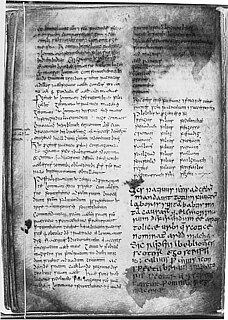 W
WThe Book of Armagh or Codex Ardmachanus, also known as the Canon of Patrick and the Liber Ar(d)machanus, is a 9th-century Irish illuminated manuscript written mainly in Latin. It is held by the Library of Trinity College Dublin. The document is valuable for containing early texts relating to St Patrick and some of the oldest surviving specimens of Old Irish, and for being one of the earliest manuscripts produced by an insular church to contain a near complete copy of the New Testament.
 W
WThe Book of Ballymote, was written in 1390 or 1391 in or near the town of Ballymote, now in County Sligo, but then in the tuath of Corann.
 W
WThe Book of Dimma is an 8th-century Irish pocket Gospel Book originally from the Abbey of Roscrea, founded by St. Cronan in County Tipperary, Ireland. In addition to the four Gospels, in between the Gospels of Luke and John, it has an order for the Unction and Communion of the Sick. The surviving illumination of the manuscript is a number of illuminated initials, three Evangelist portrait pages, and one page with an Evangelist's symbol. The pocket gospel book is a distinctively Insular format, of which the Book of Mulling is another leading example.
 W
WThe Book of Durrow is a medieval illuminated manuscript gospel book in the Insular script style. It was probably created between 650 and 700. The place of creation may perhaps have been Durrow Abbey in Ireland or a monastery in Northumbria in northeastern England or perhaps Iona Abbey in western Scotland—the place of origin has been debated by historians for decades without a consensus emerging. The Book of Durrow was probably at Durrow Abbey by 916. Today it is in the Library of Trinity College Dublin.
 W
WThe Book of Fenagh is a manuscript of prose and poetry written in Classical Irish by Muirgheas mac Pháidín Ó Maolconaire in the monastery at Fenagh, West Breifne. It was commissioned by Tadhg Ó Rodaighe, the coarb of the monastery, and is believed to derive from the "old Book of Caillín", a lost work about Caillín, founder of the monastery. Ó Maolconaire began work about 1516.
 W
WThe Book of Kells is an illuminated manuscript Gospel book in Latin, containing the four Gospels of the New Testament together with various prefatory texts and tables. It was created in a Columban monastery in either Britain or Ireland and may have had contributions from various Columban institutions from both Britain and Ireland. It is believed to have been created c. 800 AD. The text of the Gospels is largely drawn from the Vulgate, although it also includes several passages drawn from the earlier versions of the Bible known as the Vetus Latina. It is a masterwork of Western calligraphy and represents the pinnacle of Insular illumination. It is also widely regarded as one of Ireland's finest national treasures. The manuscript takes its name from the Abbey of Kells, which was its home for centuries.
 W
WThe Book of Leinster, is a medieval Irish manuscript compiled c. 1160 and now kept in Trinity College, Dublin, under the shelfmark MS H 2.18. It was formerly known as the Lebor na Nuachongbála "Book of Nuachongbáil", a monastic site known today as Oughaval.
 W
WThe Book of Lismore, also known as the Book of Mac Carthaigh Riabhach, is a late fifteenth-century Gaelic manuscript that was created at Kilbrittain, Co. Cork, Ireland, for Fínghean Mac Carthaigh, Lord of Carbery (1478–1505). Defective at beginning and end, 198 leaves survive today, containing a miscellany of religious and secular texts written entirely in Irish.
 W
WThe Book of Mulling or less commonly, Book of Moling, is an Irish pocket Gospel Book from the late 8th century. The text collection includes the four Gospels, a liturgical service which includes the "Apostles' Creed", and in the colophon, a supposed plan of St. Moling's monastery enclosed by two concentric circles.
 W
WThe Book of the de Burgos, or Book of the Burkes, is a late 16th-century Gaelic illuminated manuscript. It is held by the Library of Trinity College Dublin as MS 1440, Historia et Genealogia Familiae de Burgo.
 W
WThe Book of the White Earl is an Irish religious and literary miscellany created c. 1404–1452.
 W
WThe Cathach of St. Columba is a late 6th century Insular psalter.
 W
WCodex Usserianus Primus is an early 7th-century Old Latin Gospel Book. It is dated palaeographically to the 6th or 7th century. It is designated by r.
 W
WCogad Gáedel re Gallaib is a medieval Irish text that tells of the depredations of the Vikings and Uí Ímair dynasty in Ireland and the Irish king Brian Boru's great war against them, beginning with the Battle of Sulcoit in 967 and culminating in the Battle of Clontarf in 1014, in which Brian was slain but his forces were victorious. The chronicle, which compares King Brian to Augustus and Alexander the Great, was written in the early twelfth century, at least a hundred years after the events it describes. Much of the narrative is drawn from the earlier Annals of Ulster.
 W
WThe Confederate Oath of Association was an oath of allegiance made by Irish Confederate Catholics during the Wars of the Three Kingdoms (1638–53).
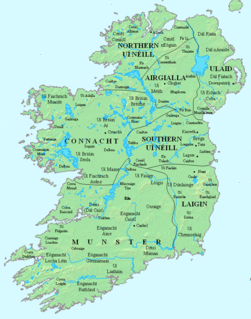 W
WMuintir Murchada was the name of an Irish territory which derived its name from the ruling dynasty, who were in turn a branch of the Uí Briúin. The name was derived from Murchadh mac Maenach, King of Uí Briúin Seóla, who died 891.
 W
WThe Domhnach Airgid is an 8th-century Irish metalwork and wooden cumdach, since 1847 in the National Museum of Ireland in Dublin. It is traditionally associated with Saint Patrick, who was thought to have had it in his possession at one point. The shrine was built in three main phases; in the late 8th and 9th centuries, and in the 14th and 15th centuries. It is thus considered a mixture of the early Insular art and later International Gothic styles.
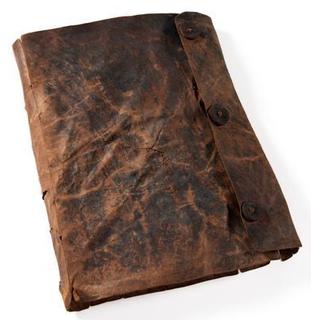 W
WThe Faddan More Psalter is an early medieval Christian psalter or text of the book of Psalms, discovered in a peat bog in July 2006, in the townland of Faddan More in north County Tipperary, Ireland. The manuscript was probably written in about 800 CE in one of a number of monasteries in the area. A unique feature is that the inside of the leather cover is lined with papyrus, probably as a stiffening, an indication of the links between the Irish and Coptic churches at the time. After several years of conservation work, the psalter went on display at the National Museum of Ireland in Kildare St, Dublin in June 2011.
 W
WBritish Library, Add MS 40618 is a late 8th century illuminated Irish Gospel Book with 10th century Anglo-Saxon additions. The manuscript contains a portion of the Gospel of Matthew, the majority of the Gospel of Mark and the entirety of the Gospels of Luke and John. There are three surviving Evangelist portraits, one original and two 10th century replacements, along with 10th century decorated initials. It is catalogued as number 40618 in the Additional manuscripts collection at the British Library.
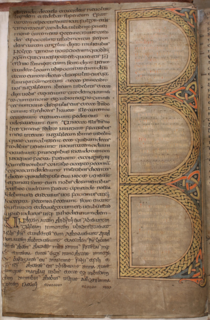 W
WDurham Cathedral Library, Manuscript A.II.10. is a fragmentary seventh century Insular Gospel Book, produced in Lindisfarne c. 650. Only seven leaves of the book survive, bound in three separate volumes in the Durham Cathedral Dean and Chapter Library. Although this book is fragmentary, it is the earliest surviving example in the series of lavish Insular Gospel Books which includes the Book of Durrow, the Lindisfarne Gospels, the St. Teilo Gospels and the Book of Kells.
 W
WThe (Great) Book of Lecan is a medieval Irish manuscript written between 1397 and 1418 in Castle Forbes, Lecan, in the territory of Tír Fhíacrach, near modern Enniscrone, County Sligo. It is in the possession of the Royal Irish Academy.
 W
WHiberno-Saxon manuscripts are those manuscripts made in Ireland and Great Britain from about 500 CE to about 900 CE in England, but later in Ireland and elsewhere, or those manuscripts made on the continent in scriptoria founded by Hiberno-Scottish or Anglo-Saxon missionaries and which are stylistically similar to the manuscripts produced in Ireland and Britain. It is almost impossible to separate Anglo-Saxon, Irish, Scottish and Welsh art at this period, especially in manuscripts; this art is therefore called Insular art. See specifically Insular illumination and also Insular script. For English manuscripts produced after 900, see the List of illuminated Anglo-Saxon manuscripts.Antwerp Sedulius Barberini Gospels Bibliothèque Nationale MS lat. 10861 Lives of Saints Gospels of Saint Gatien of Tours Ambrosiana Jerome Ambrosiana Orosius Bodleian Ovid (Oxford, Bodleian Library MS Auct. F. 4. 32, ff. 37-47 Bodleian Philippus Book of Armagh Book of Cerne Book of Deer Book of Dimma Book of Durrow Book of Kells Book of Mulling Book of Nunnaminster Gospel Book British Library Add MS 36929 Psalter British Library Harley MS 1023 Gospel Book Gospels of Mael Brigte Cadmug Gospels Canterbury Gospels Cathach of St. Columba Codex Amiatinus Codex Bigotianus Codex Eyckensis Codex Usserianus Primus Codex Usserianus Secundus Cologne Collectio Canonum Cotton-Corpus Christi Gospel Fragment Cuthbert Gospel of St John British Library - for binding Cutbercht Gospels Durham Cassiodorus Durham Cathedral Library A. II. 10. Gospel Book Fragment Durham Cathedral Library A. II. 16. Gospel Book Fragment Durham Gospels Echternach Gospels Freiburg Gospel Book Fragment Gotha Gospels Harburg Gospels Hereford Gospels Karlsruhe Bede Leiden Pliny Leiden Priscian Leipzig Gospel Book Fragment Leningrad Bede Leningrad Gospels Leningrad Paulinus Lichfield Gospels Lindisfarne Gospels Lothian Psalter Macdurnan Gospels MacRegol Gospels Milan Theodore Rawlinson Gospels Ricemarch Psalter Royal Gospel Book Royal Irish Academy MS D. II. 3 Gospel of St. John Royal Prayer Book Salaberga Psalter Southampton Psalter St. Gall Gospel Book St. Gall Gospel of St. John St. Gall Priscian Stockholm Codex Aureus Stonyhurst Gospel - for binding Stowe Missal Stuttgart Psalter Tiberius Bede Trier Gospels Turin Gospel Book Fragment Utrecht Gospel Book Fragment (Utrecht, Universiteitsbibliotheek MS 32 Valenciennes Apocalypse Vespasian Psalter Vitellius Psalter Wurzburg St. Paul
 W
WThe Leabhar Branach [l̠ʲəuɾˠ ˈbˠɾˠan̪ˠəx], also called the (Poem) Book of the O'Byrnes is an Early Modern Irish anthology of poetry collected in the early 17th century. It consists of poetry in praise of the O'Byrne family, who ruled a region known as Gabhal Raghnaill in modern County Wicklow. The poems were written between roughly 1550 and 1630, a time of turmoil in Ireland that saw the Desmond Rebellions, Nine Years' War and O'Doherty's rebellion.
 W
WAn Leabhar Breac, now less commonly Leabhar Mór Dúna Doighre or possibly erroneously, Leabhar Breac Mic Aodhagáin, is a medieval Irish vellum manuscript containing Middle Irish and Hiberno-Latin writings. The manuscript is held in the library of the Royal Irish Academy in Dublin, where it is catalogued as RIA MS 23 P 16 or 1230.
 W
WLebor Gabála Érenn, known in English as The Book of Invasions, is a collection of poems and prose narratives in the Irish language intended to be a history of Ireland and the Irish from the creation of the world to the Middle Ages. There are a number of versions, the earliest of which was compiled by an anonymous writer in the 11th century. It synthesised narratives that had been developing over the foregoing centuries. The Lebor Gabála tells of Ireland being settled six times by six groups of people: the people of Cessair, the people of Partholón, the people of Nemed, the Fir Bolg, the Tuatha Dé Danann, and the Milesians. The first four groups are wiped out or forced to abandon the island; the fifth group represent Ireland's pagan gods, while the final group represent the Irish people.
 W
WLebor na hUidre [ˈl͈ʲevor nˠə huiðʲrʲə] or the Book of the Dun Cow is an Irish vellum manuscript dating to the 12th century. It is the oldest extant manuscript in Irish. It is held in the Royal Irish Academy and is badly damaged: only 67 leaves remain and many of the texts are incomplete. It is named after an anachronistic legend that it was made from the hide of a dun cow by Saint Ciarán of Clonmacnoise.
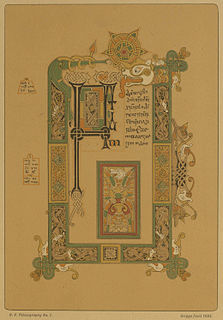 W
WThe Mac Durnan Gospels or Book of Mac Durnan is an early medieval Irish illuminated manuscript containing the four Gospels, now in the collection of the Lambeth Palace Library in London.
 W
WThe Psalter of Caimín is a medieval Irish illuminated manuscript likely produced in the 11th century, possibly on the island of Inis Cealtra in Lough Derg. It is badly damaged, with only fragments surviving. These consist of six folios, containing verses 1-16 and 33-116 of Psalm 118, a psalm that would have had 176 versus in total, and was a favourite of the early Irish church. It is possible that the Psalter only ever consisted of this full psalm, perhaps also with notes and commentary, although it may have been much larger, containing the entire Psalter. It kept in the library of University College Dublin (MS.A.i)
 W
WThe Chronicles and Memorials of Great Britain and Ireland during the Middle Ages, widely known as the Rolls Series, is a major collection of British and Irish historical materials and primary sources published as 99 works in 253 volumes between 1858 and 1911. Almost all the great medieval English chronicles were included: most existing editions, published by scholars of the 17th and 18th centuries, were considered to be unsatisfactory. The scope was also extended to include legendary, folklore and hagiographical materials, and archival records and legal tracts. The series was government-funded, and takes its unofficial name from the fact that its volumes were published "by the authority of Her Majesty's Treasury, under the direction of the Master of the Rolls", who was the official custodian of the records of the Court of Chancery and other courts, and nominal head of the Public Record Office.
 W
WThe Southampton Psalter is an Insular illuminated Psalter from Ireland. It is asserted by some to be from ninth-century in date, while other scholars have argued for a tenth- or even early eleventh-century dating. It has illuminations including three full page miniatures and also contains numerous annotations in both Latin and Old Irish.
 W
WThe Stowe Missal, which is, strictly speaking, a sacramentary rather than a missal, is an Irish illuminated manuscript written mainly in Latin with some Old Irish in the late eighth or early ninth century, probably after 792. In the mid-11th century it was annotated and some pages rewritten at Lorrha Monastery in County Tipperary, Ireland. Also known as the Lorrha Missal, it is known as the "Stowe" Missal as it once belonged to the Stowe manuscripts collection formed by George Nugent-Temple-Grenville, 1st Marquess of Buckingham at Stowe House. When the collection was bought by the nation in 1883, it and the other Irish manuscripts were handed over to the Royal Irish Academy in Dublin, where it remains, catalogued as MS D II 3. The cumdach or reliquary case which up to this point had survived together with the book was later transferred, with the rest of the Academy's collection of antiquities, to the National Museum of Ireland. The old story was that the manuscript and shrine left Ireland after about 1375, as they were collected on the Continent in the 18th century, but this appears to be incorrect, and they were found inside a stone wall at Lackeen Castle near Lorrha in the 18th century.